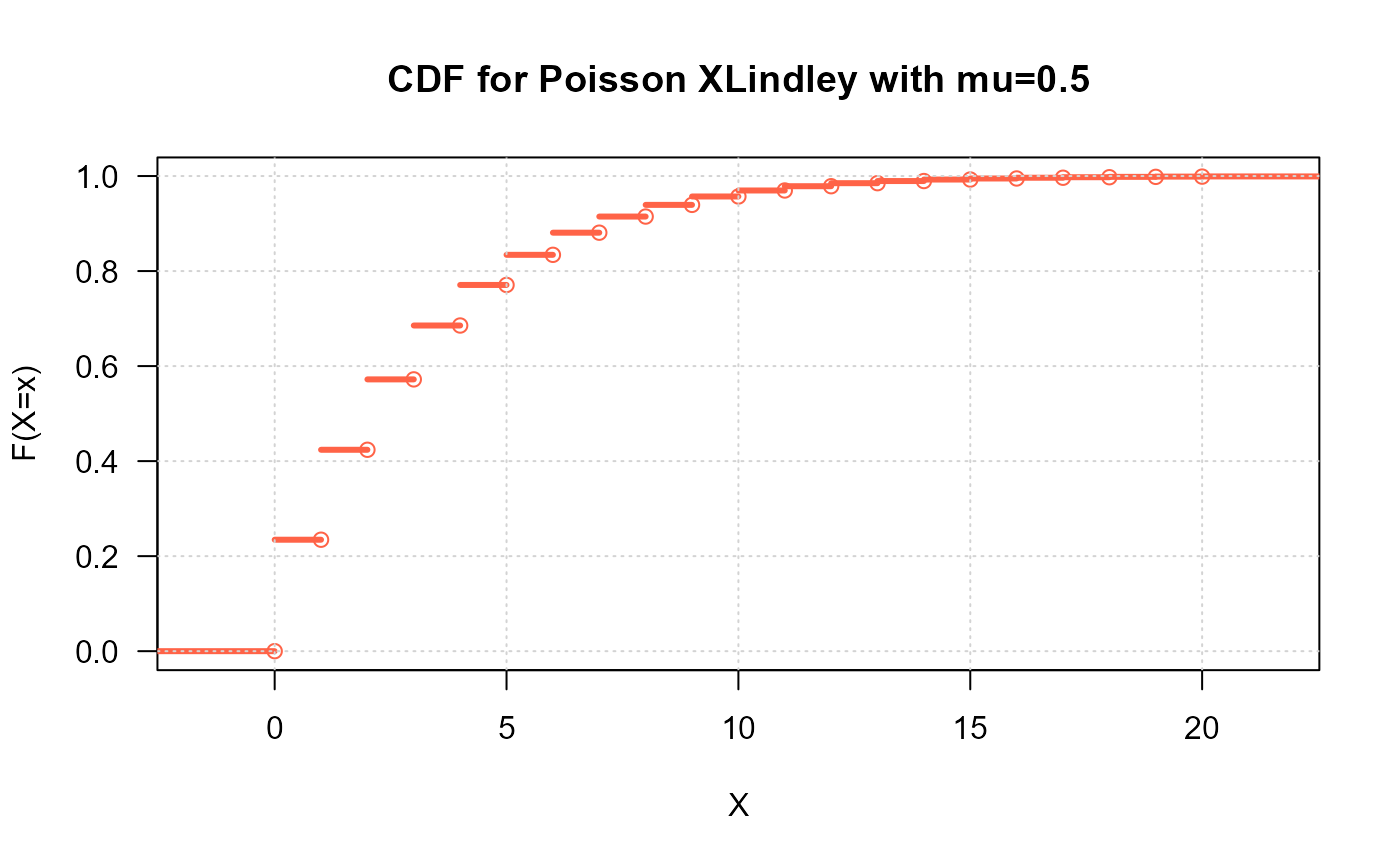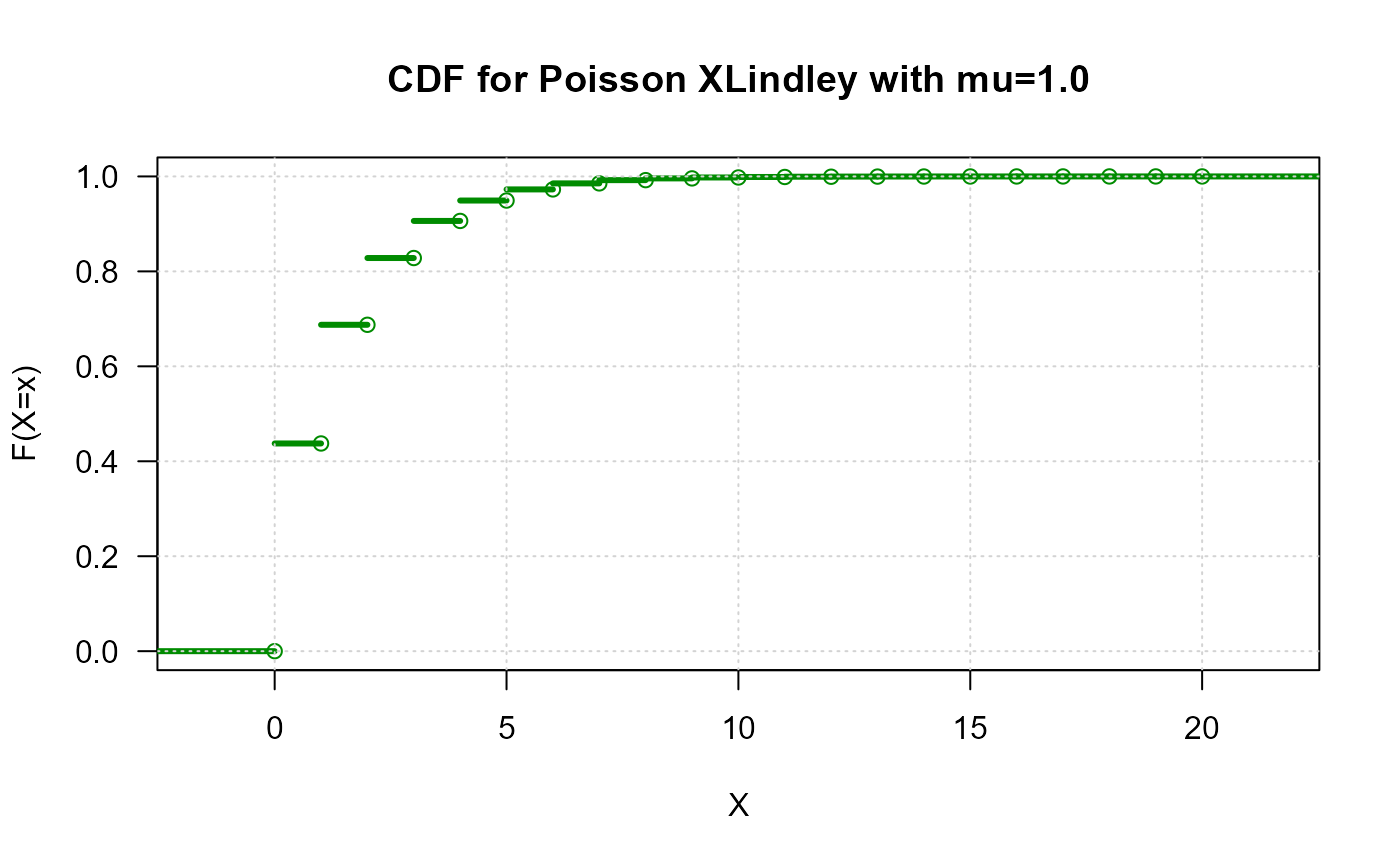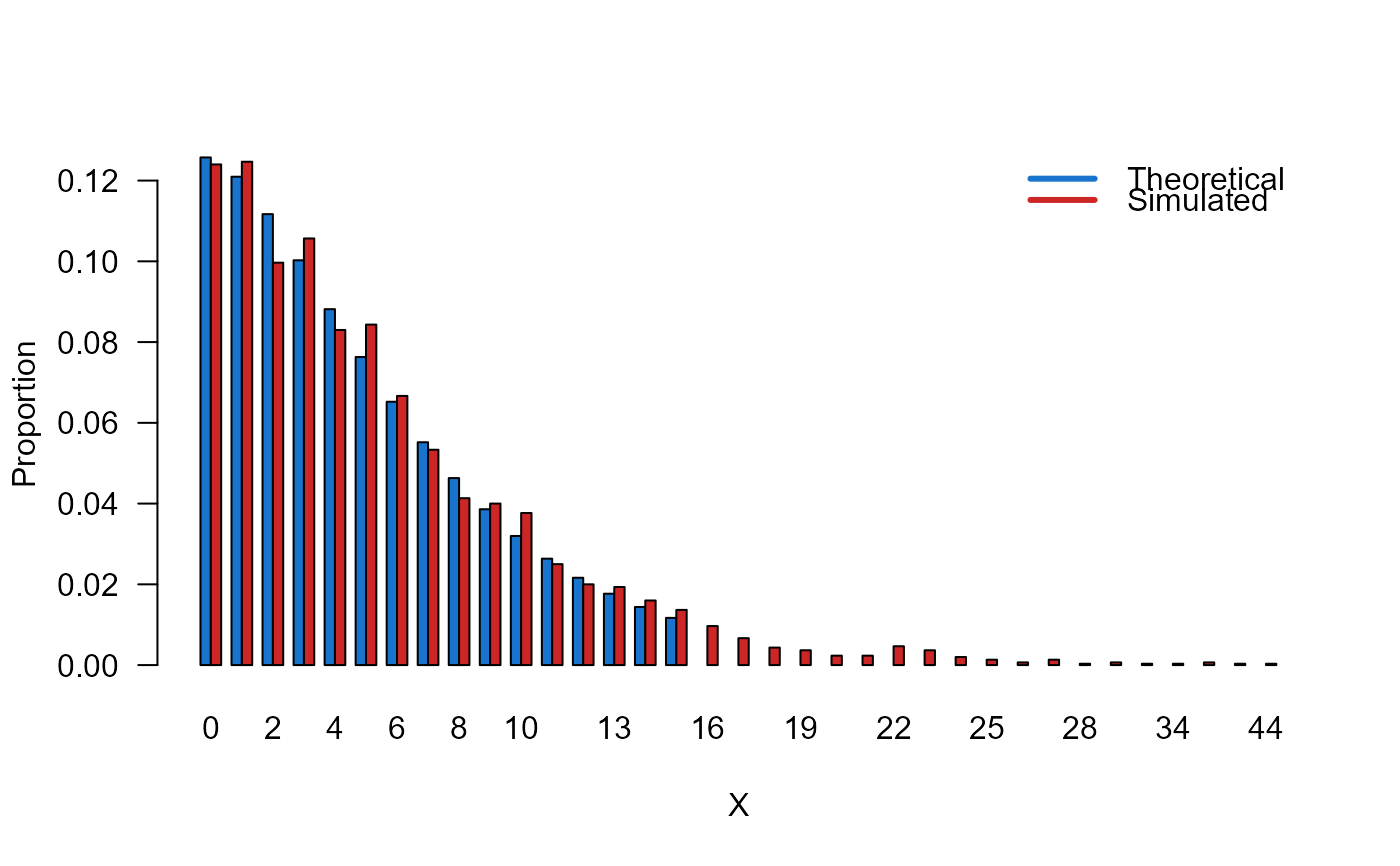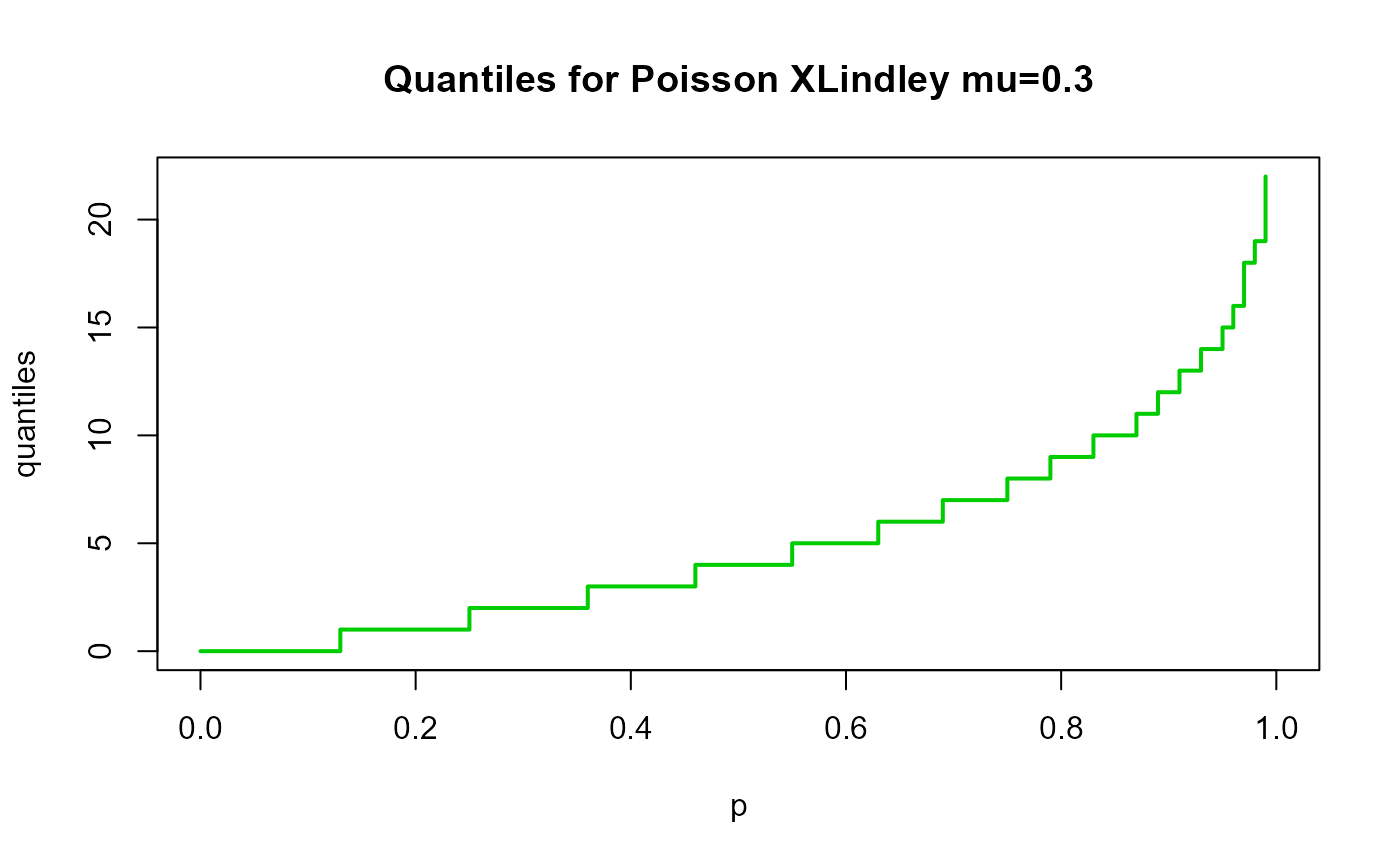These functions define the density, distribution function, quantile function and random generation for the Discrete Poisson XLindley distribution with parameter \(\mu\).
dPOISXL(x, mu = 0.3, log = FALSE)
pPOISXL(q, mu = 0.3, lower.tail = TRUE, log.p = FALSE)
qPOISXL(p, mu = 0.3, lower.tail = TRUE, log.p = FALSE)
rPOISXL(n, mu = 0.3)Arguments
- x, q
vector of (non-negative integer) quantiles.
- mu
vector of the mu parameter.
- log, log.p
logical; if TRUE, probabilities p are given as log(p).
- lower.tail
logical; if TRUE (default), probabilities are \(P[X <= x]\), otherwise,
P[X > x].- p
vector of probabilities.
- n
number of random values to return
Value
dPOISXL gives the density, pPOISXL gives the distribution
function, qPOISXL gives the quantile function, rPOISXL
generates random deviates.
Details
The Discrete Poisson XLindley distribution with parameters \(\mu\) has a support 0, 1, 2, ... and mass function given by
\(f(x | \mu) = \frac{\mu^2(x+\mu^2+3(1+\mu))}{(1+\mu)^{4+x}}\); with \(\mu>0\).
Note: in this implementation we changed the original parameters \(\alpha\) for \(\mu\), we did it to implement this distribution within gamlss framework.
References
Ahsan-ul-Haq, M., Al-Bossly, A., El-Morshedy, M., & Eliwa, M. S. (2022). Poisson XLindley distribution for count data: statistical and reliability properties with estimation techniques and inference. Computational Intelligence and neuroscience, 2022(1), 6503670.
See also
Examples
# Example 1
# Plotting the mass function for different parameter values
x_max <- 20
probs1 <- dPOISXL(x=0:x_max, mu=0.2)
probs2 <- dPOISXL(x=0:x_max, mu=0.5)
probs3 <- dPOISXL(x=0:x_max, mu=1.0)
# To plot the first k values
plot(x=0:x_max, y=probs1, type="o", lwd=2, col="dodgerblue", las=1,
ylab="P(X=x)", xlab="X", main="Probability for Poisson XLindley",
ylim=c(0, 0.50))
points(x=0:x_max, y=probs2, type="o", lwd=2, col="tomato")
points(x=0:x_max, y=probs3, type="o", lwd=2, col="green4")
legend("topright", col=c("dodgerblue", "tomato", "green4"), lwd=3,
legend=c("mu=0.2", "mu=0.5", "mu=1.0"))
 # Example 2
# Checking if the cumulative curves converge to 1
x_max <- 20
plot_discrete_cdf(x=0:x_max,
fx=dPOISXL(x=0:x_max, mu=0.2), col="dodgerblue",
main="CDF for Poisson XLindley with mu=0.2")
# Example 2
# Checking if the cumulative curves converge to 1
x_max <- 20
plot_discrete_cdf(x=0:x_max,
fx=dPOISXL(x=0:x_max, mu=0.2), col="dodgerblue",
main="CDF for Poisson XLindley with mu=0.2")
 plot_discrete_cdf(x=0:x_max,
fx=dPOISXL(x=0:x_max, mu=0.5), col="tomato",
main="CDF for Poisson XLindley with mu=0.5")
plot_discrete_cdf(x=0:x_max,
fx=dPOISXL(x=0:x_max, mu=0.5), col="tomato",
main="CDF for Poisson XLindley with mu=0.5")
 plot_discrete_cdf(x=0:x_max,
fx=dPOISXL(x=0:x_max, mu=1.0), col="green4",
main="CDF for Poisson XLindley with mu=1.0")
plot_discrete_cdf(x=0:x_max,
fx=dPOISXL(x=0:x_max, mu=1.0), col="green4",
main="CDF for Poisson XLindley with mu=1.0")
 # Example 3
# Comparing the random generator output with
# the theoretical probabilities
x_max <- 15
probs1 <- dPOISXL(x=0:x_max, mu=0.3)
names(probs1) <- 0:x_max
x <- rPOISXL(n=3000, mu=0.3)
probs2 <- prop.table(table(x))
cn <- union(names(probs1), names(probs2))
height <- rbind(probs1[cn], probs2[cn])
mp <- barplot(height, beside = TRUE, names.arg = cn,
col=c("dodgerblue3","firebrick3"), las=1,
xlab="X", ylab="Proportion")
legend("topright",
legend=c("Theoretical", "Simulated"),
bty="n", lwd=3,
col=c("dodgerblue3","firebrick3"), lty=1)
# Example 3
# Comparing the random generator output with
# the theoretical probabilities
x_max <- 15
probs1 <- dPOISXL(x=0:x_max, mu=0.3)
names(probs1) <- 0:x_max
x <- rPOISXL(n=3000, mu=0.3)
probs2 <- prop.table(table(x))
cn <- union(names(probs1), names(probs2))
height <- rbind(probs1[cn], probs2[cn])
mp <- barplot(height, beside = TRUE, names.arg = cn,
col=c("dodgerblue3","firebrick3"), las=1,
xlab="X", ylab="Proportion")
legend("topright",
legend=c("Theoretical", "Simulated"),
bty="n", lwd=3,
col=c("dodgerblue3","firebrick3"), lty=1)
 # Example 4
# Checking the quantile function
mu <- 0.3
p <- seq(from=0, to=1, by = 0.01)
qxx <- qPOISXL(p, mu, lower.tail = TRUE, log.p = FALSE)
plot(p, qxx, type="s", lwd=2, col="green3", ylab="quantiles",
main="Quantiles for Poisson XLindley mu=0.3")
# Example 4
# Checking the quantile function
mu <- 0.3
p <- seq(from=0, to=1, by = 0.01)
qxx <- qPOISXL(p, mu, lower.tail = TRUE, log.p = FALSE)
plot(p, qxx, type="s", lwd=2, col="green3", ylab="quantiles",
main="Quantiles for Poisson XLindley mu=0.3")
